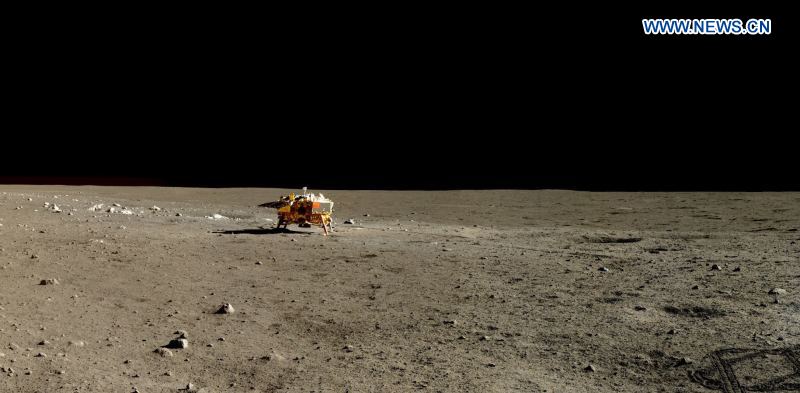|
|
| Photo provided by National Astronomical Observatories of Chinese Academy of Sciences shows a high-resolution image of lunar surface on the moon. The image is shot by Chinese Chang'e 3, an unmanned lunar exploration probe, and Yutu rover. (Xinhua) |
Data sent back to the Earth by Chinese lunar probe Chang'e 3 has proved for the first time that there is no water on the moon, said a Chinese astronomer.
The Chang'e 3 has gathered data on the moisture content above the lunar surface and "got a figure so low that we have never seen before," said Wei Jianyan, a researcher of the National Astronomical Observatory at the Chinese Academy of Sciences.
The result is in line with the expectations of experts. It's also the first time that mankind has proved there is no water on the moon.
Also, the Chang'e 3 has achieved several other firsts in the scientific field. It drew the first geological section map of the moon and found a lunar basaltic rock, which can help us understand the evolution of the moon.
It also conducted the first survey of the celestial body above the north pole of the moon, which can help astronomers do comparison studies in the future.
Also, it has obtained the first images of the Earth's plasmasphere, which will be a boon to space weather forecasts, terrestrial communication and the communication between the Earth and spacecrafts.
The Chang'e 3 has been working continually on the moon since its soft landing in December 2013. According to the State Administration of Science, Technology and Industry of National Defense, this is the longest operation of lunar probes.
The Chang'e 3 is composed of a lander and a lunar rover called "Yutu" (Jade Rabbit). It carries eight scientific instruments, including panoramic cameras, a soil probe, a lunar-based optical telescope and an extreme ultraviolet (EUV) camera to observe the moon, the Galaxy and the Earth.
Quelle: China org
---
|
Chang'e 3 gathers plenty of data in past 30 months
|
|
China's lunar probe Chang'e 3 has been roaming around the moon for the last two and a half years. Working for 33 lunar nights, it now has the honor of being the probe which has operated the longest on the moon's surface. It has collected 7 terabytes of data including pictures and videos that have been sent to over 1,000 colleges, universities and scientific institutions on the Chinese mainland, in Hong Kong and Macao. Chang'e-3, with China's first moon rover aboard, successfully landed on the moon in December 2013, marking China's first successful soft-landing on the surface of an extraterrestrial body. However its rover Jade Rabbit became faulty and shut down in early 2014. Luckily, it awoke shortly after and has lasted beyond its life expectancy. The Chang'e 3 mission has provided scientists with an enormous number of images which reveal valuable details about the lunar surface. It made the first ever geological map of the moon with lunar penetrating radar, providing an insight into the evolution of the moon and the basis to explore its resources. Lin Yangting, a researcher from the Chinese Academy of Sciences, says the rover even discovered a new type of rock - the Lunar Basalt. "The radar detected three layers of basalt under the ground. The top layer is 195 meters deep. This indicates that until the late period, about two billion years since it was born, there were still huge amounts of magma that were erupting. This shows that the activity of the magma on the moon lasted longer than expected." Lin's colleague Wei Jianyan says Chang'e 3 also gathered data which confirmed speculation that there is no water on the moon. "We measured the amount of water on the lunar surface and above, and found only very small quantities, which is in line with the expectations of the experts on the formation of the moon." In addition, Chang'e 3's optical telescope made observations of the moon in the ultraviolet range at its north pole to provide information for comparison studies in the future. Equipped with the world's first extreme ultraviolet imager, Chang'e 3 has been able to study changes in the plasmasphere to monitor solar storms that could disrupt telecommunications on earth. Liu Tongjie, deputy director of the moon exploration center at the State Administration of Science, Technology and Industry for National Defense, says the success of the Chang'e 3 has guaranteed China a leading role in moon exploration. "Since the 1990s, the international community has conducted 13 lunar explorations, including five by the United States and four by China. China ranks second in terms of both the frequency of exploration and the scientific achievements. We can say that China has reached the advanced level in some areas of lunar exploration, and this has stimulated the development of moon exploration in the world." China is planning to send another probe to the moon - the Chang'e 5 robotic lunar sample return mission - which is due to be launched in 2017 from the new Wenchang Satellite Launch Center. China has more launches coming up in its space missions. The Tiangong 2 orbiting space lab has been delivered to the Jiuquan Satellite Launch Center where it will liftoff later this year. It will dock with the crewed Shenzhou 11 spacecraft and a Tianzhou cargo vessel which are slated for launch later. Quelle: CRJ |


